Feed aggregator
Character Creation Challenge: D&D 5th Edition, Van Richten's and Tasha's
It's the 1st of October and that means a new Character!
The Game: D&D 5th Edition
Van Richten's Guide to Ravenloft & Tasha's Cauldron of Everything

While I did 5e way back in January, I wanted to revisit character creation with the new details from Van Richten's Guide to Ravenloft and Tasha's Cauldron of Everything. This is also the closest I can get right now to what might be the standards for D&D 5 Revised.
For this build, I went with the Soulknife Rogue from Tasha's and the Dhampir from Van Richten's. Yes. I had something in mind already.
The Character: BloodRayne
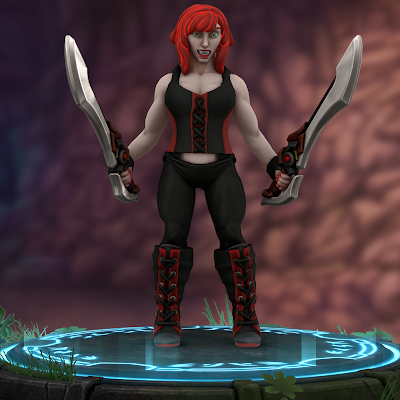 One of the best ways for me to test out a character in a new system is to take a character I already know well. If I am going to test out the Dhampir rules in D&D then I am going to need a dhampir I know well, and that means Rayne.
One of the best ways for me to test out a character in a new system is to take a character I already know well. If I am going to test out the Dhampir rules in D&D then I am going to need a dhampir I know well, and that means Rayne.I have done stats for Rayne, the titular character of the BloodRayne video game series (and movie series from Uwe Boll), for both Unisystem and Superbabes. She does have a D&D 5e connection with Laura "Jester" Bailey voicing the character in the video games long before she rose to geek fame in Critical Role.
Rebuilding Rayne with the new features in both Tasha's and Van Richten's was actually rather easy. I had a concept in mind and the rules allowed me to re-create her with no issues. Mind you this is a "D&D Rayne" not the BloodRayne from the video games. Despite the grief D&D 5 gets for being "superheroic" I could not emulate all her moves or powers. I suppose I could have gone with a little bit of warlock and in particular a Hexblade (and I still might). But I wanted something that would fit in well enough with a D&D party.
I wanted to take advantage of all the new features, so I used D&D Beyond. You can see her character sheets here and PDF version here.
Friday Fantasy: Lady Trevant’s Bones
 Lady Trevant’s Bones is an adventure for Dungeons & Dragons, Fifth Edition. Published by Critical Kit, it is designed for a party of four to five Player Characters of Sixth Level and is intended to be played in a single session, either as a one-shot or as part of an ongoing campaign. It involves two warring factions of Elves, a peace summit, an ancient tomb, hallowed ground, and a dread necromancer. The scenario involves some interaction, but primarily emphasises combat and exploration.
Lady Trevant’s Bones is an adventure for Dungeons & Dragons, Fifth Edition. Published by Critical Kit, it is designed for a party of four to five Player Characters of Sixth Level and is intended to be played in a single session, either as a one-shot or as part of an ongoing campaign. It involves two warring factions of Elves, a peace summit, an ancient tomb, hallowed ground, and a dread necromancer. The scenario involves some interaction, but primarily emphasises combat and exploration.Lady Trevant’s Bones takes place on Orphan’s Bay at the far reaches the Cantorus Dynasty, the default setting for many of the adventures from Critical Kit. Here the leaders of two long feuding nations of Elves, the underworld dwelling Evershades and the maritime Midnight Banner, both descended from the same sea-faring Sea Elves that split roughly four thousand years ago, have come together at the Perigee Summit in light of terrible news. A necromancer and Moonshade exile, T’Zraam, has broken into the tomb of Lady Trevant, the first leader of the Evershades, and is probably going to try and raise her from the dead and in doing so, take command of the Evershades Elves. Unfortunately, neither participant at the Perigee Summit can send anyone into the tomb after T’Zraam, as both the Evershades and the Midnight Banner regard her tomb as hallowed ground. Thus outsiders are needed… Enter the Player Characters.
Several reasons explain why the Player Characters have come to Orphan’s Bay and the Perigee Summit are suggested. The best and strongest simply has them deliver a sealed letter to the summit containing proof that a captured spy was not sent by either nation of Elves. This gets the Player Characters to the summit, proves their bona fides, and it makes a possible scene with the spy a whole lot easier to work into the scenario. The other suggestions, such as investigating the disappearance of the spy, wanting to look for treasure, and so on, are nowhere near as detailed as the first option, and consequently, will leave the Dungeon Master with more work to develop them and involve the Player Characters. The only issue with the involvement of the spy is that his surname is ‘Burgess’. (Fortunately, there is no MacClean.)
If the Player Characters agree to enter the tomb, they are quickly ushered to the mouth of a cave on the shore. This is the entrance to the tomb of Lady Trevant. The whole complex consists of eight locations. The first five of these consist of damp caves hung with spider’s webs and infested with spiders, and the Player Characters will have to fully explore most of these to progress to the tomb beyond. There is a simple puzzle to solve, the Player Characters having been given the means to solve it before entering the caves, and this will require them to back track a little. Once this is solved, they can descend to the tomb itself where they will encounter the first of several undead, including a multi-trunked elephantoid undead! Inside the tomb itself, the Player Characters will confront T’Zraam as the necromancer conducts the ritual to raise Lady Trevant from the dead. This should be a fairly tough fight given the encounter that the Player Characters will have had outside the tomb beforehand.
In addition to the scenario, Lady Trevant’s Bones provides the Dungeon Master with the stats for T’Zraam, three new monsters, three new magic items, and background on both the Evershades and the Midnight Banner. The latter is accompanied by a timeline for Orphan’s Bay and broaden the details known about the region. The monsters are in keeping with the setting—almost evergreen Evershade Zombies which keep coming back and may be tough to finally put down and Moonspiders, denizens of the caves who appear not to eat Elves… The treasures are good too, The Bracelet of Cardinal Points being perfect for any nautical campaign and a Spirit Box in which a ghost can be locked. Plus there is a nice bit weirdness to be found in Lady Trevant’s tomb as well.
Physically, Lady Trevant’s Bones is decently done, but it needs a further edit and the maps could have benefited from a direction compass. The full colour artwork is excellent and the Dungeon Master should certainly use it to show her players as necessary.
Lady Trevant’s Bones does need a little more development. It is not clear what happens if T’Zraam manages to raise her and if so, what does she come back as. Similarly, what happens if the Player Characters fail? Both are left to the Dungeon Master to determine.
Its short length means that Lady Trevant’s Bones is more of a mini-scenario, one that can very easily be completed in a single session or evening’s worth of play. It has a stronger emphasis on combat and exploration than roleplaying, so may well be better for some groups than others and it does leave some information for the Dungeon master to answer herself. Nevertheless, its brevity and its simplicity in terms of set-up does mean that it would be relatively add to a Dungeon Master’s campaign. All it needs is two feuding factions of Elves, whether that is High, Wood, Drow, or other.
Overall, Lady Trevant’s Bones is decent combat focused scenario for mid-Level characters which with a little effort slots easily into a campaign.
October is Horror Month
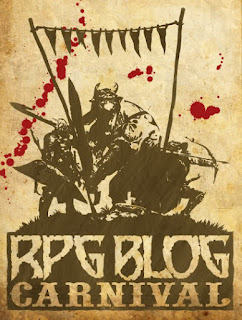 Hello and WELCOME to The Other Side. October is a big deal around here. I spend the month talking about horror. Both in terms of horror RPGs, horror movies, and anything else that strikes my interest.
Hello and WELCOME to The Other Side. October is a big deal around here. I spend the month talking about horror. Both in terms of horror RPGs, horror movies, and anything else that strikes my interest.This month I am honored to be hosting my first ever RPG Blog Carnival. Of course, I am going to be talking about horror and all the great things you can do in your RPGs.
All this month I am going to be talking about adding horror elements to your games. Whether you play D&D or Kult or Bunnies & Burrows, any game can have elements of horror to them. I hope to give you the means to add these AND also provide you a place to discuss your own horror elements.
How to Participate
Simple. Write a blog post, vlog, social media post, tweet, or what have you. The topic can be about horror, about adding horror elements to a game, or even as simple as what you are going to do for a Halloween game. Have a scary RPG-related story? Post it and post the link below!
I do have Comment Moderation turned on to help keep the spam out, so if you don't see your post just give me a bit and it will show up.
Come back here all month long to see what others are posting and linking here.
Come back to my blog all month long to see what I am posting as well!
Here's the Spookiest month of the year and my favorite time of the year.
September Interlude
Review: Lands of Adventure (1983)
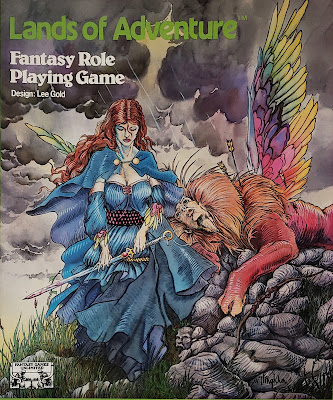 Lands of Adventure has always been something of a Holy Grail item for me. I knew very little about the game and much less about the author and designer Lee Gold. However, the cover art was striking and different from anything else I had seen before that my curiosity only grew and grew. Later on, I began to learn who Lee Gold was and her contributions to the RPGs and geek/nerd culture in general, namely via Alarums and Excursions, that game went from a passing curiosity to an "it's on the list" item.
Lands of Adventure has always been something of a Holy Grail item for me. I knew very little about the game and much less about the author and designer Lee Gold. However, the cover art was striking and different from anything else I had seen before that my curiosity only grew and grew. Later on, I began to learn who Lee Gold was and her contributions to the RPGs and geek/nerd culture in general, namely via Alarums and Excursions, that game went from a passing curiosity to an "it's on the list" item.I am happy to report that not only is Alarums and Excursions still active, so is Lee Gold, having spoken with her briefly over the summer. After that my "it's on the list" item moved to the top of my list.
Circumstances seem to hit me just right. I had seen a huge increase in my sales and a shrink-wrapped copy had been offered for sale. I had the opportunity and I had the cash. The price might have been higher than I would have normally spent, but any buyer's remorse I might have had was quickly evaporated once I got this boxed in the mail and opened it up. I am not sure what my expectations were, it had been "on the list" for so long, but now I have it and I am really thrilled with it.
Lands of Adventure (1983)
Lands of Adventure by Lee Gold was published by Fantasy Games Unlimited in 1983. The boxed set came with the Lands of Adventure Rule Book (32 pages) and a Culture Pack (28 pages) that cover Mythic Greece and Medieval England. The back cover of the rule book has a character sheet. example and the box came with one character sheet on heavy paper/light card stock that can be copied. Which I did.
The box also included some "micro dice" two d20s (white and green) and two d6s (green, with pips). The d20s are numbered 0-9, 0-9, so good for d20s or d%s. I say good for them, but in truth, they are too tiny for me to read anymore! So I am going to dig up some others to use.

The books show their wargaming roots with sections numbered as 1.0, 1.1 all the way to 28.1. The Culture Pack follows suit, but the numbers here are tied to core rules. So section 1.1 of the culture section refers also to section 1.1 of the core rules. The Culture Pack section are prefaced with a code letter, which I discuss below.
Note on the art. The cover art for the box and the books is all done by Bill Willingham and it is some of the best art I have seen of his. I do believe it is one of the best covers for a game I have seen. Certainly, it was the best cover of the time. The book covers are no less impressive for their old-school black and white.

Seriously, that medusa is 10x better than any medusa art I have seen in D&D. The interior art is by Michael Kucharski. His art is good, though not at the level of the covers. Note. Both artists have websites and both artists have, since this book, gotten to be fantastic artists. Both also did their own versions of Doctor Stange[BW, MK], so maybe I need to roll up a Doctor Strange-like character for this.
In all cases, the art fits well with the books and the content.
Core Rules
The rulebook begins with a word from the author. Of note Gold mentions using The Palladium Book of Weapons & Armour, Through Dungeons Deep: A Fantasy Gamers' Handbook, and encyclopedias of animals.
Character creation is the big piece of the first book with 11 (yes Eleven!) character attribute traits, though only about half of those are random. The others are derived. The pure random characteristics are Craft, Talent, Appearance, and Strength. Derived characteristics are Dexterity, Voice, Intelligence, Prudence, Agility, Constitution, and Charisma. So more than D&D, but far less than DragonRaid. You can also determine Gender and Height.
Typically the traits are 1-20 which makes it good for converting on a d20 roll or a d% roll. Alternately there is a point-buy system where you can distribute 110+2d10 points across all 11. I'd likely stick to the derived ones and use the points to build the completely random ones. In this way, it is not all that different to say WitchCraft. Instead of 110+2d10, maybe 45+1d10 or something for the purely random ones (range: 4-80) and derive the others as normal.
Other details include the Culture Technology Level and modification due to races other than the default human are given.
Up next (1.1) is Piety. Various actions are given that adjust this score either through pious or blasphemous actions. This aids in forms of magic.
2.0 covers measuring Vitality. For the people that really enjoy complexity in their combat there three types of "hit points" in use in this game. They are Energy Points (EP), Body Points (BP), and Life Points (LP). EPs are lost due to magic or extra actions, BPs cover injury, and LPs cover grievous injuries. Body Points are increased by armor as described later in the armor section.
3.0 Introduces the Skill systems. The characteristics above determine skills, which are the meat of the game really. There are 10 skill categories with some specialist skills. These include Communication, Knowledge, Magic, Manipulation, Miracle, Movement, Observation, Persuasion, Weapons (Melee), and Weapons (Missile). Each has its own method of calculation. Skill checks are % and roll under. A roll of 1 to 10 is considered a Maximum success and considered flawless. A roll of 96 to 100 is a Fumble.
Specialized skills are well, pretty much that. But for every 10% increase in a Specialized skill, there is a +1% increase to the category. I have not seen that before. Categories though are Hard, Normal, Easy, and by Weapon. So improvement in say use of a sword by 10% your ability to shoot arrows increases by 1%. There is a rough logic here. Categories determine how long it takes to learn a skill and how they can improve.
The next sections cover all the skills and their specialties. For example, in section 6.0 we learn there are four categories of Magic; Compulsions, Illusions, Enhancements, and Energy. Section 8.0 Miracles is set up in a similar manner.
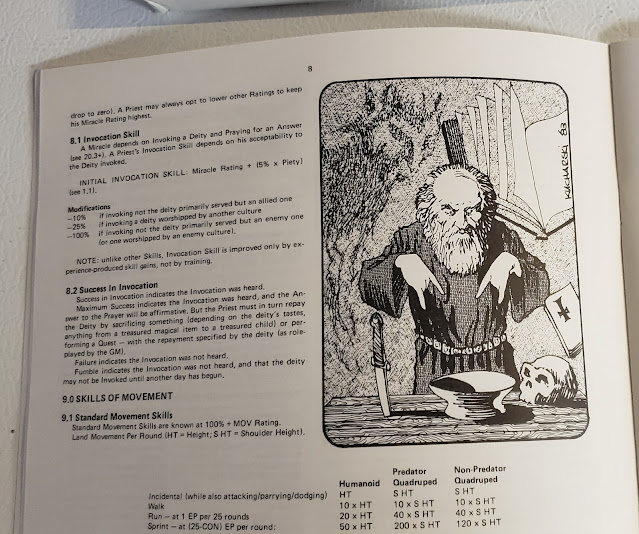
Section 12 covers our weapons and how to use them. Section 13 covers defense. Relating combat as skill is of course a feature of many games outside of the D&D world. Section 14 covers equipment.
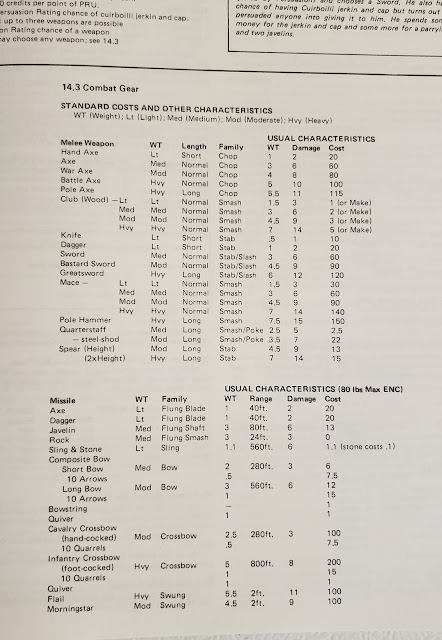
Section 15 covers time. 1 Phase = 2 seconds, 1 round = 12 seconds (6 phases), and 1 minute = 5 rounds (30 phases). Skill time is measured in phases and rounds.
Section 17 covers magic in more detail, where Section 6 just details magic as a skill. There are no "spells" as in D&D per se (see below), but how much power it takes to perform certain example feats of magic. It reminds me a bit of what we would much later get in White Wolf's Mage or Eden's WitchCraft. In 17.9 some examples of "spells" built with the rules above are given. Section 18 covers spellcasting. Doing a Doctor Strange character is making more and more sense. Much like we will see later on in games like Mage, the four categories of magic can be combined in different permutations to make different spell effects.
Section 19 covers all sorts of Daemons, Demons, and Gods. This is followed quickly Section 20 on Miracles which is given similar coverage that Spells received. Section 21 gives us Thaumaturgists or mages with quasi-priestly powers. Section 22 likewise gives us Diabolists. Miracles rely on the beings from Section 19 to work.
Section 23 covers the basic stats for animals. Section 24 does the same for humanoids, 25 for Dragons, and 26 for types of undead. None of these sections have the detail as one would see in a monster manual, the assumption being that you would create your own monsters or rely on the Culture Packs.
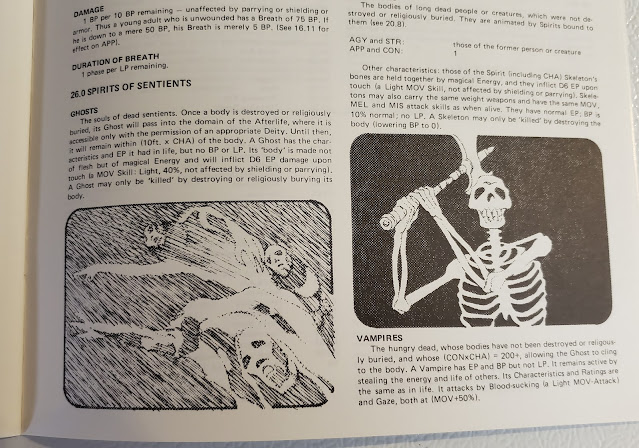
We end with a very complete index.
The rules feel incomplete to be sure, but I am certain there is a playable game here. I might be mentally filling in the blanks of what is missing with knowledge of other games and what they would do.
Culture Pack
The intent of the Culture Packs was to provide a "Game" world for the characters to play in. While not specifically addressed, the assumption was I felt that these would be separate. Separated by time as they are in the real world. This is different than the take of Man, Myth & Magic which has all of the Mytho-Historical worlds existing together. There is a bit higher level of scholarship in our two worlds than what is typically seen in say Man, Myth & Magic.
It is explicitly stated that there would be more Culture Packs, but sadly no others were made. I could easily see Viking Age Northmen, Knights of Charlemagne, the Roman Empire, and Edo Period Japan. In fact, given Ms. Gold's previous game, Land of the Rising Sun, Edo Japan seems like an easy choice. I might have to have a look as Land of the Rising Sun and see if I can divorce it enough from Chivalry & Sorcery roots to make a "Culture Pack" for it. Gold would go on to write the GURPS Japan supplement. Likewise, the Viking era also seems like a given the Vikings game she did for I.C.E. later on.
This Culture Pack covers Mythic Greece and Medieval England. With each getting half the book.
Layout-wise the two sections follow the same pattern and the pattern set up in the Core Rules. As mentioned the Section numbers match those of the Core book. "C" is used for Mythic Greece (see below) and "M" for Medieval England. So in the Core rules, 1.0 covers humans with 1.0b nonhumans (like Elves, Dwarves, Giants). Section C1.0b covers centaurs, giants, and various nymphs. Section M1.0b cover faeries and picts.
Mythic Greece is given the title "Children of the Gods," thus the "C" in the section numbering. I approve, I used the same title (though without knowledge of this book) for my own coverage of Greek myths and Classical witches in Children of the Gods. This Culture Pack covers Ancient Greece before the Trojan War. The rules here make subtle changes to the Core rules as well as some additions. The big feature here naturally is the inclusion of more gods, festivals, and other creatures.

Medieval England moves the action North and about 2,000 years or so in the future, about the time of the Fall of the Western Roman Empire in England or 1070 CE. Coverage is given for England of the time. So one of my favorite topics, the confrontations of Christianity and the "Old Religion" of Celtic Paganism. So tips are given for role-playing as well as various rule changes. The formula used here to build the Culture Packs is very effective. Had this game been more successful I would have loved to have seen more.
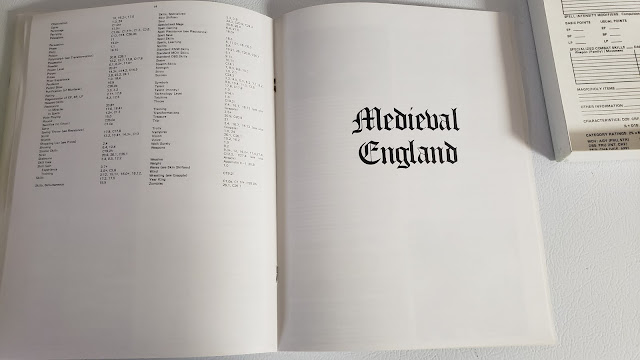
Interestingly enough, much like my own Children of the Gods did with her Mythic Greece, there are connections here between her Medieval England and my other Basic Witch book, The Craft of the Wise. The connections are pretty obvious. We were reading the same research at the time/from the time. We both went into the coverage of Greek Myths by Robert Graves. For Medieval England, there are certainly a lot of material she could have used, but she also picked a few that were also on my list like the works of Margaret Murry ("The Witch-Cult in Western Europe") and poets like Kipling. It makes me wonder how my own books might have been different if I had seen Lee Gold's interpretations first. As suspected the Magic sections cover witches, familiars, and coven casting. All of it is very much right out of Murray's books. I have to admit I was a touch surprised not to see Frazer's "The Golden Bough" in her list of research.
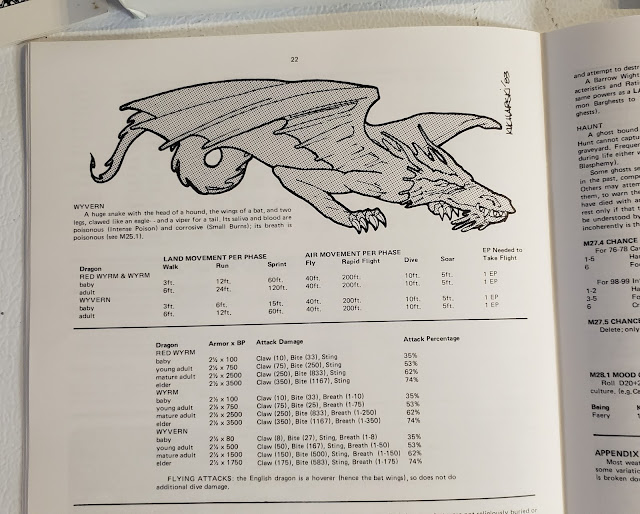
Afterword
Lee Gold is still very active in producing Alarums and Excursions and she still plays Lands of Adventure with her group. I spoke to her over the summer and she is fantastic.
The game does have a "collected notes" feel to it as other reviewers have mentioned. That doesn't detract from a very fascinating, if involved game. I am certain that with Gold as a Game Master it is all quite fluid and dynamic, first time GMs will be spending a lot of time looking up formulas and a lot of pre-game prep building monsters, NPCs and the like.
I paid quite a lot for this game in it's original shrink wrap and I have to say I am not disappointed. It is such a fascinating snapshot of one designer's passion. While this could be construed as a "vanity project" it is not overly so. Lee Gold is obviously a great game designer. The diamonds of this game though are still hidden under a lot of coal.
I hope to spend some more time with it soon.
Unboxing Pictures
It's rare I get something from the 1980s still in shrink. Let's take it in.
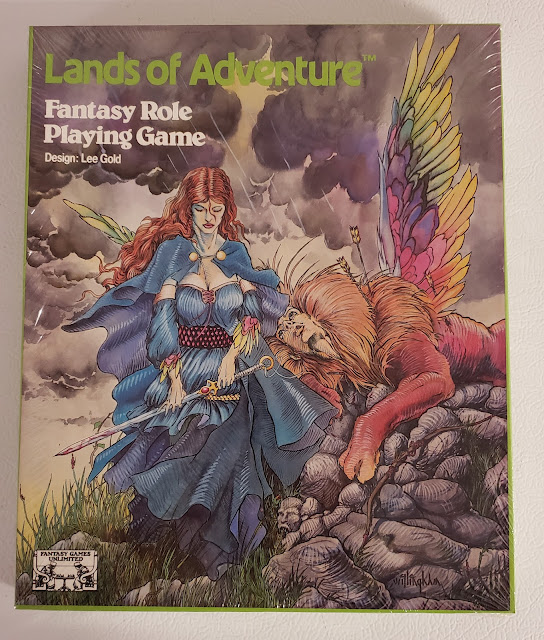
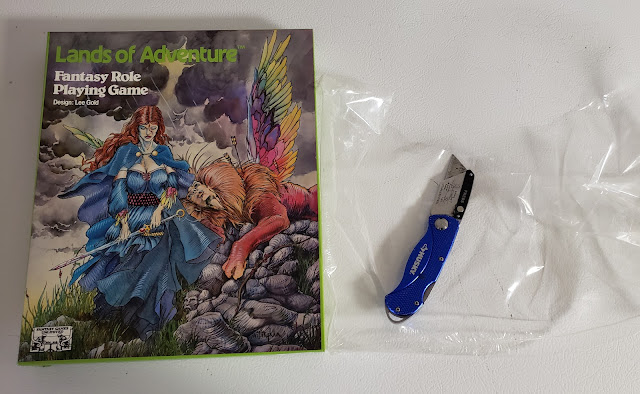


Links
- Wayne's Books Unboxing. Glad I watched this AFTER my review. We agreed on a lot of points. His box is pretty much exactly like mine.
- Coverage on Wayne's Books site.
- Review by faoladh at the Ongoing Campaign. We agree on a lot points, but I think I liked it better.
- Grognardia's interview with Lee Gold
- Meet the Woman Who by 1976 Was the Most Important Gamer in Roleplaying After Gary, DMDavid
- Voyages in Eternity: RPG Archive: Lands of Adventure
Travels Abroad: Cincinnati
One Man's God Special: Syncretism Part 2, the Greco-Egyptian Gods
In the mythologies of the Ancient World, there are two that really stand out. The Greek and the Egyptian. Both cultures grew to great prominence and fundamentally shaped our world. Both had fascinating tales of gods, monsters, and heroes.
Thanks to the trade and eventual rule of the Ptolemaic Pharos, we have a set of syncretized Greco-Egyptian gods.
While I would happily sit here and talk about these gods in an academic sense, my goal with OMG is really to present these from the lens of D&D, and from the Deities & Demigods in particular. I am going to stick with gods that were actually worshiped, or at least recognized. For this, I am going to rely on the scholarship of others, in particular, that of Dr. Kathrin Kleibl at the German Maritime Museum in Bremerhaven. I am drawing heavily from her chapter (Chapter 41) in The Oxford Handbook of Ancient Greek Religion. She has written more, ok lots more, and her work could form the cornerstone of a new pantheon for a new Deities & Demigods II if such a thing were feasible.
Ptolemaic Egyptian Mythos
In 323 BCE Alexander the Great controlled Egypt, his reign, however, was short-lived and his general Ptolemy took control and his family ruled until 31 CE when they were taken over by Rome. The famous Cleopatra (Cleopatra VII) was the last of their line. The Ptolemaic Pharos or Ptolemaic Kings were not Egyptian but were Greek. They ruled and lived a Greek lifestyle. Only Cleopatra is recorded to have actually learned some of the Egyptian languages. The gods they created or were created around them had a unique blending of both Greek and Egyptian features. Not just physical features, though that is true as well, but religious features and aspects.
 Zeus-Serapis
Zeus-SerapisBy the time Ptolemy took the throne, there was already syncretism happing in the Egyptian worldview. Serapis was a new popular god figure that combined Osiris with the Apis Bull. In some places, Serapis had already supplanted Osiris as the main God. Zeus-Serapis was an "artificial" conflating of Zeus with Serapis. I say artificial because it was believed he was created by the ministers of Ptolemy I to have a God that could be worshipped by Greeks and Egyptians alike. Newer research has shed some doubt on this interpretation, but for our uses here it does not matter his actual source, only what he became after that.
Zeus was the god of the sky, Osiris was the god of the dead and the god of the Pharos. Zeus-Serapis became the God of the Sun and of Healing. In this, he effectively takes over the "portfolios" of Apollo, Helios, and Ra. As protector of the dead, this also includes the benevolent nature of Hades.
Isis
Isis went from the wife of Osiris and potentially one of the most powerful goddesses in the myths to the Mother of the Gods and thus the pharos. The Ptolemaic Pharos would often take on the epithet of "Sons of Isis." Isis remained a popular goddess well into the Roman age.
Isis was also combined with Aphrodite, a goddess of unknown origin herself. Given the connections between Isis and other goddess like Astarte, Innana, and Ishtar, this sets Isis up as the primary female divinity of the Ancient world.
The "Mysteries of Isis" became a mystery religion that had some outward similarities to the Greek Eleusinian Mysteries associated with Demeter. Her cult with tied to that of Zeus-Serapis, effectively becoming a Father and Mother figure to the Ptolemaic dynasty. In this respect, she takes on the kinder natures of Hera and the dedication of Isis. she would be the one called upon by women in childbirth. Especially when we consider what is going on with Horus.

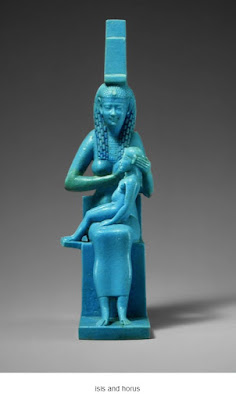
Horus/Harpokrates
To complete the "holy trinity" of Father-Mother-Child the Greeks renamed Horus, or 'Har-pa-chered' literally "Horus the Child." as Harpokrates. Where he was envisioned as a child-like divinity. Gone was the Avenger Horus and now we get a proto-Christ Child in his place.
Images of Isis nursing the infant Horus would later go on to influence the depictions of the Virgin Mary with infant Jesus.
Anubis/Hermanubis
While not equated with any Greek God in particular Anubis appears as a guide to Isis and advisor of Zeus-Serapis. Some of Osiris' duties as lord of the dead get transferred to Annubis.
In some cases, we have a syncretized Hermes-Anubis, or Hermanubis, as a psychopomp and protector of the dead.
Seth
Going a touch outside of Dr. Kleibl's work we get the god Seth. Also known as Set and Suketh and Setekh. He originally was the good protector god of Upper Egypt. But this was 3,000 years before the Ptolemies. More time between us and the Ptolemies to be honest. Over the centuries Set changed from this benevolent god to the murderer of Osiris and the force of all evil and chaos in the world.
Seth was the name the Greeks called him, and they associated him most with the monster Typhon. Interestingly enough, I find no conflation with Seth and Hades inDr. Kleibl's text. While both were seen as dark, chthonic figures, the Greeks in Egypt did not equate them. But there are still some.
Set/Nephthys and Hades/Persephone
While the associations are not perfect there is a similarity between the relationship of Set and Nephthys with that of Hades and Persephone. Both Nephthys and Persephone are considered goddesses of the underworld and mourning. Both are attached to husbands they would rather leave. Both Hades and Set are complicated gods that are often viewed as evil. Both have been accused of raping or at least coercing their future wives.
I have not found any direct relationship to suggest that they were synchronized, the option certainly feels valid. The conflation of Set with Hades is one of the suspected origins of the Christian Devil; in particular the association of the devil in the desert or "the wilderness" (in Matthew) when he tempts Jesus. Set is the god of the desert and wild places. Though I am not aware of any scholarship that has uncovered a synchronized Set-Hades (see Serapis above).
Nephthys was also commonly conflated with the Greek Nys, Goddess of the Night. As it turns out "Nephthys" is already the Greek name for the Goddess the Egyptians knew as Nebt-het or Nebhet.
Hermes Trismegistus
Not part of Dr. Kleibl's work, but one that really put me on the road to this. Hermes Trismegistus is the synchronized version of Hermes and Thoth. Hermes Trismegistus may have been less of a worshipped figure and more of a translation error when the Greeks were translating the Egyptian writing (hieroglyphic and Demotic). Hermes Trismegistus became more important in later medieval times as the author of the Hermetic Texts.
Heka
This one is also not part of Dr. Kleibl's research but one of my own creations based on her, and other, research. I talked about the Hecate / Heka connections back when I did OMG: Greek Myths and OMG: Egyptian Myths. With the loss of Isis as the Goddess of Magic we have Heka as the new Goddess of Magic and the Underworld. Her relationship with Isis is the same as that of Ishtar with Ereshkigal. This also makes her the perfect goddess of witches.
Hecate was also conflated with the Egyptian Heqet, the Goddess that was the midwife to Isis when Horus was born. Indeed the Greeks also conflated her with Ereshkigal. In this respect she could be considered the sister to the Mother Goddess Isis.
Others
There were plenty more, but it is difficult to know whether these were worship syncretic gods or part of the Interpretatio graeca where the Greeks often substituted names of other gods for their own gods.
For example, the Greek Asclepius is often equated with the Egyptian Imhotep to become the patron of Healing.
The Greek Adonis is equated with the Egyptian Osiris, the Sumerian Dumuzid, and the Phoenician Tammuz to all be equivalent Gods of Agriculture and Grain. This is the same "God figure" of James Frazer's "The Golden Bough." Another god that fits this is the Greek God Dionysus, who is also conflated with Adonis and Osiris.
Looking over this "pantheon" I quickly note there is no god of war. There was Montu for the Egyptians, but the "god of war" was also served by Anhur, Ra, Sekmet, and Set at various times. The Greeks and Romans had Ares and Mars respectively in addition to Athena-Minerva. You see more syncretism with Ares/Mars in later periods, especially with the gods of the Celts and European peoples.
The Greeks did know of Anhur and they called him "Onuris." This is the god of war and battle. His primary goal is to drive out the enemies of Egypt (and Greece). If we were so inclined we could add all the "avenger" aspects lost by Horus when he became Harpokrates. In this, he takes on the role of Protector of Isis, which of course means the protector of Egypt and the line of the Pharohs.
Game Play Uses
It was not AD&D that sent me down the road of this Ptolemaic Egyptian Mythos, but rather Gary Gygax's other game, Dangerous Journeys. Gary's Ægypt fascinated me when I first read about it in the 90s. So much so that when I wanted an Egyptian-like land I used large chunks of this along with Arypt from Mystara and Erypt from the World of Greyhawk. All of this together gave me my Ærypt.
While it would be best to use the Egyptian gods, RAW, from the Deities & Demigods, using these has appeal, even if I have no idea how the "Greeks" got into my world. Maybe something else altogether is in order for that. A future post maybe.
For this "new" Pantheon I would want to relate these Gods in AD&D terms. This is after all the primary focus of One Man's God, not as a treatise on comparative religions. I also don't want or even need, D&DG-style stat blocks. These are not "monsters" to be fought.
I am taking the important bits from the AD&D D&DG, namely"power" levels of the various gods, their alignment, and their worshipper's alignments. While not stated as "Domains" (that's a 3rd Edition term) I am using them here. These are roughly the same as 2nd Ed's "Spheres."
Serapis
Greater God
Alignment: Lawful Good
Worshipper Alignment: Any Good
Domains: Law, Sun, Sky (including storms and rains), the Dead, Rulers
Symbol: Sun
Isis
Greater Goddess
Alignment: Neutral Good
Worshipper Alignment: Any Good, Women (Mysteries of Isis)
Domains: Motherhood, the Home, Childbirth, Love, Fertility
Symbol: Moon or the Roman symbol for Venus
Harpokrates
Greater God
Alignment: Lawful Good
Worshipper Alignment: Any Good
Domains: Life
Symbol: Ankh
Seth
Greater God (or Intermediate God)
Alignment: Chaotic Evil
Worshipper Alignment: Any Evil
Domains: Darkness, Chaos, Desolation
Symbol: Coiled Snake
Nephthys
Greater Goddess (or Intermediate God)
Alignment: Chaotic Neutral
Worshipper Alignment: Any
Domains: Night, Darkness, the Underworld
Symbol: Dark moon
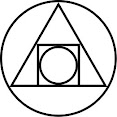 Hermes Trismegistus
Hermes TrismegistusGreater God (or Intermediate God)
Alignment: Neutral
Worshipper Alignment: Any
Domains: Knowledge, Wisdom, Secrets
Symbol: A circle within a square within a triangle within a circle.
Heka
Lesser Goddess
Alignment: Lawful Neutral
Worshipper Alignment: Any, Witches
Domains: Magic, Witchcraft, Childbirth, Darkness
Symbol: Crescent moon
Adonis (Dionysus-Osiris)
Lesser God
Alignment: Lawful Neutral
Worshipper Alignment: Any
Domains: Agriculture, Grain, Wine, Life-Death-Rebirth
Symbol: Sheath of grain
Onuris
Lesser God
Alignment: Chaotic Neutral
Worshipper Alignment: soldiers, warriors
Domains: War
Symbol: Spear
Asclepius-Imhotep
Demigod
Alignment: Neutral Good
Worshipper Alignment: Any, Healers
Domains: Healing
Symbol: Scalpel
What About the Demons?
This is all fun and everything, but what about the demons of this mythology? We have a "devil" in the form of Seth. I would say that given Egypt's history with demons that some would still be around, but maybe in an altered form. I think given the Greek connection that Demogorgon would be a good choice too. Especially if I move Seth over to Lawful Evil (more devil-like).
With the influences of the Greeks and Romans, Late Period Egypt had an increase in creatures that were more related to the Greek daimon. Demons went from creatures that guarding firey gates to creatures that plagued the Earth with troubles. Egypt at this time was also part of the larger trade routes of first Greece then the Roman Empire, so many gods, goddesses, and demons were filtered through the lens of both ancient and "modern" Egyptian religion.
Guardian Demons
Gate, or Guardian Demons, or ![]() were the most common sort and were usually created by the Gods. Their job was to keep mortals out of their realms. They are demons in the sense that they are supernatural creatures that are neither mortals nor are they gods. These creatures were also described in funerary texts, their names or epithets placed on coffins to protect the dead. They were fierce creatures. Apep and Ammit from the OMG Egyptian Myths could fit this role, but there are others with names like In-tep, Chery-benut, and Ikenty. Ikenty was a large bird-like monster with the head of a cat.
were the most common sort and were usually created by the Gods. Their job was to keep mortals out of their realms. They are demons in the sense that they are supernatural creatures that are neither mortals nor are they gods. These creatures were also described in funerary texts, their names or epithets placed on coffins to protect the dead. They were fierce creatures. Apep and Ammit from the OMG Egyptian Myths could fit this role, but there are others with names like In-tep, Chery-benut, and Ikenty. Ikenty was a large bird-like monster with the head of a cat.
Wanderer Demons
The other class of demons were the Earthly or wanderer demons, ![]() . These are the demons who cause problems on Earth, gave people nightmares, caused disease, and possessed humans.
. These are the demons who cause problems on Earth, gave people nightmares, caused disease, and possessed humans.
I have a Part 4 of this series to do later. I plan on incorporating some of the work of Prof. Panagiotis Kousoulis of the University of the Aegean, Greece. Most of his work is in Greek, so I am digging around for English translations. Part 4 takes this concept of syncretism and demons and dials it up.
But I need to do my Part 3 first.
W.V. Cockburn - Bram Stoker Illustrations, 1882
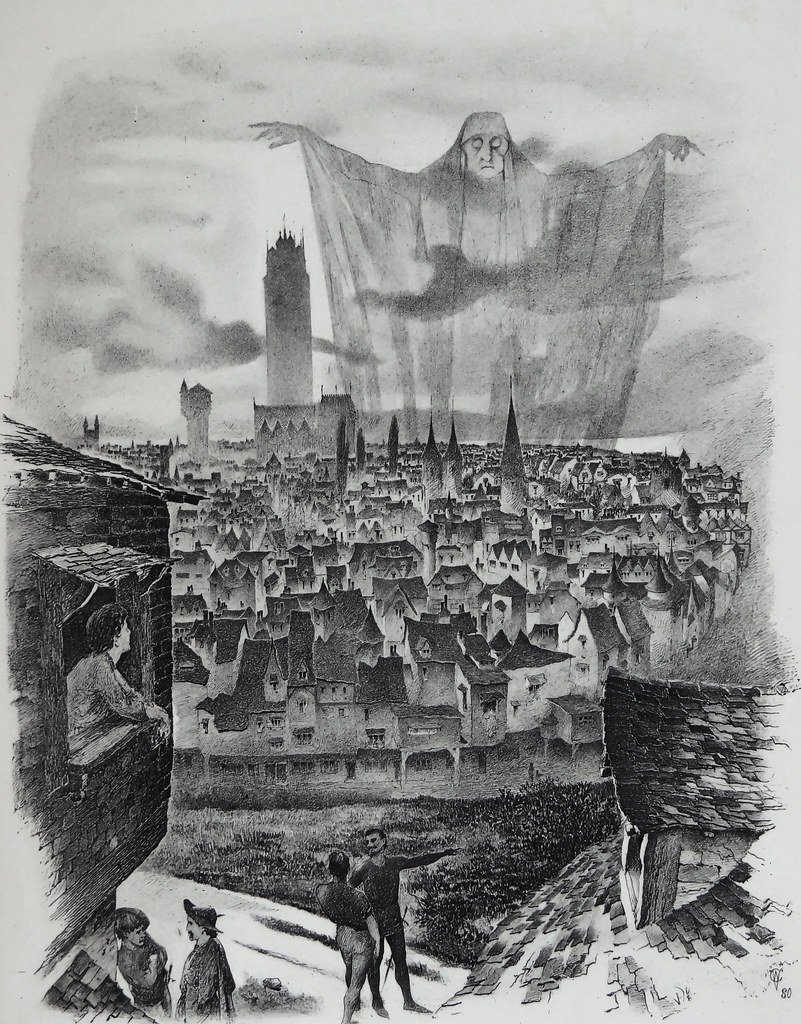 Illustration for "In the sky she saw a vast shadowy figure." from “Under the Sunset” by Bram Stoker, 1882
Illustration for "In the sky she saw a vast shadowy figure." from “Under the Sunset” by Bram Stoker, 1882
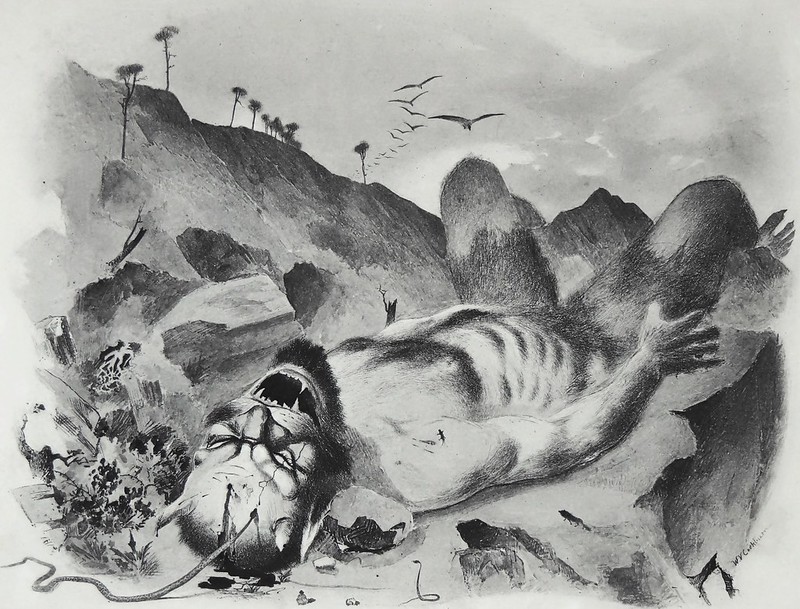 Illustration for "Prince Zaphir slays the Giant" from “Under the Sunset” by Bram Stoker, 1882
Illustration for "Prince Zaphir slays the Giant" from “Under the Sunset” by Bram Stoker, 1882
Artworks found thanks to Leo Boudreau.
The Six Million Hits Man
At some point earlier this morning I hit a new milestone; 6 Million hits.
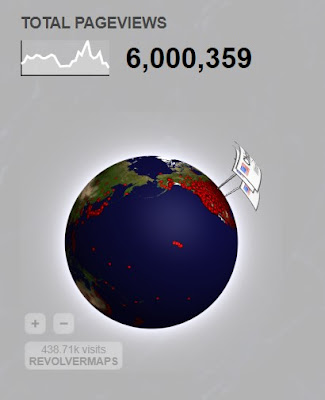
I was not expecting this until sometime tomorrow. I had some ideas planned for posts, but they were fairly vain navel-gazing, and self-aggrandizing. So instead let me just thank everyone for coming back all these years and reading my strange little corner of the internet.
Still, it is a nice milestone to hit.
Travels Abroad: New Jersey
D&D 5.5 Announcement
Over the weekend WotC/Hasbro and D&D team had their D&D Celebration. Lots of things were discussed including the new gift box I talked about yesterday.
Of course, the big announcement was D&D 5.5 or D&D 5 Revised coming out in 2024.
Personally, I think this is a good idea.

Right now D&D 5 is 7 years old. The "Basic Rules" PDF and the Starter Set were released in July 2014. In 2024, the proposed release date, D&D 5 will be close to 10 years old. That is about the same amount of time AD&D 1st and 2nd Ed were around each. That is counting the unofficial ".5" versions of post Unearthed Arcana (AD&D 1) and the Revised AD&D 2nd ed books. This puts D&D 5e and 5.5 combined to be the longest-lasting version of D&D.
There are a ton of reasons why 2024 is a good date for this.

The Hype
I have been saying EVERYWHERE that WotC will not do anything until the 50th anniversary of D&D in 2024. They can spend the first two-quarters of 2024 hyping D&D from its roots and evolution. Expect a huge deep dive into nostalgia. Then third quarter (or even fourth to get that Christmas dollar) D&D 5.5 will hit the shelves. The message from WotC will be clear, you have enjoyed D&D for 50 years now and THIS is the ultimate edition. It's not just good marketing, they would be negligent if they didn't do it.
The Rules
When I heard about this I mentioned it to my son last night when he got home from work. His response was, "oh cool!" I have seen similar responses from others in the D&D 5 community. With the publication of Tasha's and other books, there have been enough rule additions and alternates to make a Revised Core Rule Set a welcome publication.
Right now we are being told these are just going to be rule clarifications and reorganizations. Everything will be 100% backward compatible. This is smart given the number of people that play D&D 5 now. It also makes sense given how poorly Pathfinder 2 was received by the fans of Pathfinder 1.
Plus D&D 5 was designed to be more modular, so adding in rules should be easy. Maybe not as modular as D&D 4e was nor as modular as D&D 5 was originally advertised as, but still better than D&D 3 and anything that came before it.
Of there are critics. I note that most of the complaining is coming from people that have self-admitted that they actually don't play D&D 5. So I guess their opinions really don't matter.
Expectations
What am I expecting with these new rules?
Well, "race" will be gone and we will get something closer to the Ancestry and Culture mods other games have been doing. Mechanically speaking it will largely be the same at the end. Instead of choosing a race and getting a baked-in mod and language; you will choose ancestry, culture and there will be guidelines for mods, languages, and other features. So what if you were a human raised by elves? Or an orc raised by dwarves? These things can now happen. Well, in truth you could always do these you just needed a DM that would work out the details with you and not be dogmatic.
There will still be a Basic Rules style game with the four basic classes (Cleric, Fighter, Rogue, Wizard) and the four basic "races" (Human, Elf, Dwarf, Halfling) they will just be worked up in terms of the new ancestry rules. But mechanically a 5.0 elf will work as a 5.5 elf.
Rangers will get tweaked. Again. Cause no one is ever happy with them. This goes all the way back to the beginning really.
Warlock might get some changes, as will the monks. We MIGHT get a Core Rule psionic class, but the chances are very low.
I am expecting some new Session 0 verbiage.
Monsters will have a "typical" alignment with sentient races not having one required. The new Wild Beyond the Witchlight monsters all have alignments listed. The idea will be that Ancestry plays a role in alignment, but individuals have a choice. I DO expect to see a group of good or at least neutrally aligned Drow.
There are spellcasting changes coming to monsters that we will get a preview of in 2023 with the Multiverse of Monsters book.
I am also expecting more on non-combat play like we have in the Wild Beyond the Witchlight.
I am sure there will be more and many of the changes will be minor, less than the changes between 3.0 and 3.5 for example. OR even the differences between 2nd Ed and Revised 2nd Ed.
Looking forward to seeing what happens.
Jonstown Jottings #46: GLORANTHA: The search for the Throne of Colymar
Much like the Miskatonic Repository for Call of Cthulhu, Seventh Edition, the Jonstown Compendium is a curated platform for user-made content, but for material set in Greg Stafford’s mythic universe of Glorantha. It enables creators to sell their own original content for RuneQuest: Roleplaying in Glorantha, 13th Age Glorantha, and HeroQuest Glorantha (Questworlds). This can include original scenarios, background material, cults, mythology, details of NPCs and monsters, and so on, but none of this content should be considered to be ‘canon’, but rather fall under ‘Your Glorantha Will Vary’. This means that there is still scope for the authors to create interesting and useful content that others can bring to their Glorantha-set campaigns.
—oOo— What is it?
What is it?GLORANTHA: The search for the Throne of Colymar is a scenario for use with RuneQuest: Roleplaying in Glorantha.It is a five page, full colour, 1.92 MB PDF.
The layout is clean and clean. It is art free, but the cartography is excellent.
Where is it set?
GLORANTHA: The search for the Throne of Colymar is set in Sartar, but need not necessarily be set in the lands of the Colymar tribe.
Who do you play?
Player Characters of all types could play this scenario, but is best suited for Orlanth worshippers. A Lhankor Mhy priest or scholar may find some of the background to one of the scenarios to be of interest. In addition, Player Characters with the Passion ‘Hate (Aldryami)’ will be challenged by one or more of the encounters.
GLORANTHA: The search for the Throne of Colymar requires RuneQuest: Roleplaying in Glorantha and the Glorantha Bestiary. The Glorantha Sourcebook will be useful for its background to the scenario.
What do you get?GLORANTHA: The search for the Throne of Colymar is a hunt for a lost artefact, the throne of Colymar, the founder of the Colymar tribe. Whoever finds it will greatly add to his reputation, as well as bring great prestige to his king or chief, especially if they are of the Colymar tribe. The identity of that king or chief will very much depend upon the year in which the Game Master sets the scenario. Leila Black Spear and Prince Argrath are suitable candidates depending upon the year, but there are many others.
To find the Throne of Colymar the Player Characters have to make an overland journey, perhaps suffer an encounter or two, and come to Chief Colymar’s home. The building is only described in brief detail and whilst there is some lore to be discovered if the Player Characters can get past its protection—the scenario does not suggest any specific solutions—the emphasis in the scenario is more on the encounters with monsters and creatures, random and otherwise.
GLORANTHA: The search for the Throne of Colymar is not badly written, but it is underwritten. As presented it is not a whole scenario, but rather the end of a scenario. Despite the fact that true Player Characters are on a quest to find an ancient artefact, there is no investigation and no research involved in the scenario, no sense of mystery or magic, there is no sense of peril or urgency, there are no rivals also searching for Colymar’s throne. Simply as presented, the scenario starts at the home of Chief Colymar.
Similarly, for the home of an ancient tribal chief, the descriptions of his home are underwhelming. As to the description of Colymar’s throne—there is none. It could be that it is nothing more than a chair, but it could also have been something more… As equally, could GLORANTHA: The search for the Throne of Colymar.
Is it worth your time?Yes—GLORANTHA: The search for the Throne of Colymar contains the germ of an interesting scenario if the Game Master is willing to write the first half and inject it with a sense of urgency and mystery that its author did not.No—GLORANTHA: The search for the Throne of Colymar is half a scenario and half a scenario is no scenario at all. Cheap, but avoidable.Maybe—GLORANTHA: The search for the Throne of Colymar contains the germ of an interesting scenario if the Game Master is willing to write the first half and inject it with a sense of urgency and mystery that its author did not.
D&D Rules Expansion Gift Set
This week the social media networks were all a-buzz with a mysterious new product for D&D. Some were saying new boxed set or even D&D 6th ed (which was highly unlikely in any event) we learned today what we will be getting.
So this,

Has now been replaced by this,
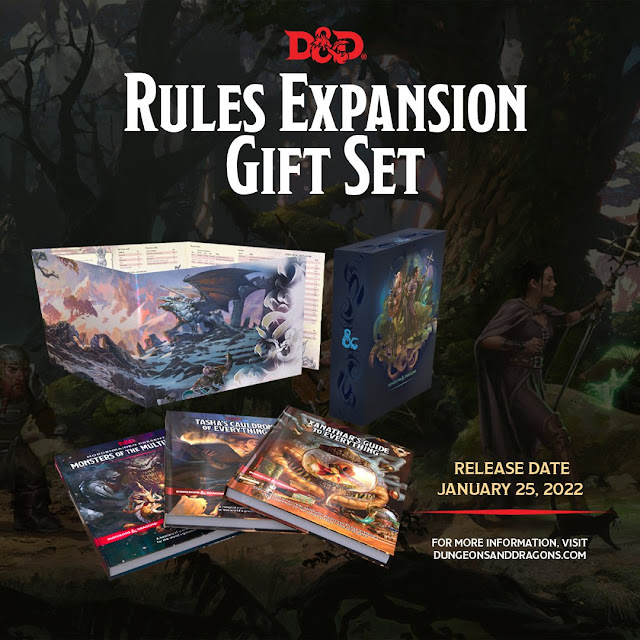
and this,
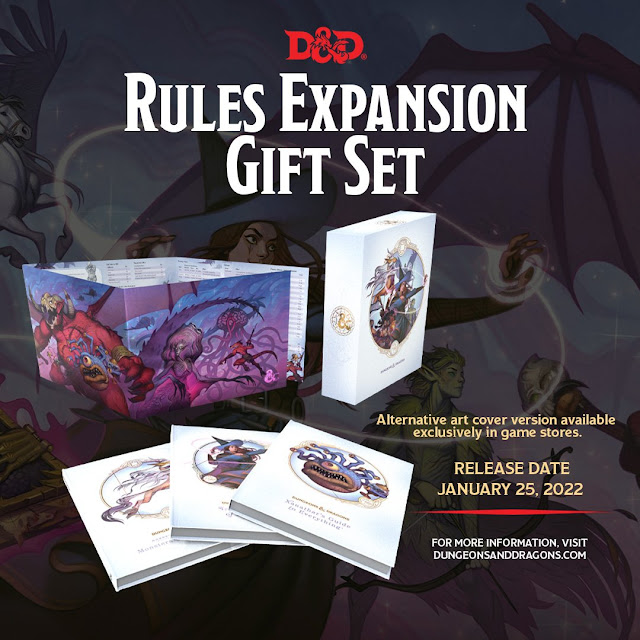
The set includes Xanathar's Guide to Everything, Tasha's Cauldron of Everything, and the new Mordenkainen Presents Monsters of the Multiverse.
It was supposed to be for Christmas, but the global supply chain is still screwed up.
In any case, it looks really cool. Typically I get one for me and the special edition one for my son. But I think I might get the special ed version for myself as well. They look so great.
A Bounty of Action & Action Points
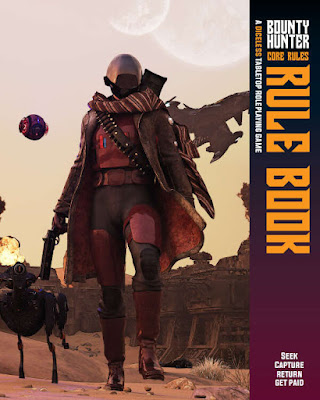 Bounty Hunter – A Diceless Tabletop Roleplaying Game is designed as the world’s easiest roleplaying game—and it is. Mostly. Published by Great GM following a successful Kickstarter campaign, it is a Science Fiction roleplaying game in which the Player Characters are galactic bounty hunters. The need for law enforcement has grown to the point where it has not only been commercialised, but institutionalised, and whatever their species, their background and their former occupations, today’s bounty hunters are graduates of Bounty Hunter School. Now they ‘Seek Capture Return Get Paid’. Their clients are governments, law enforcement, corporations, and even individuals. It is a lucrative business, but expenses, in particular, operating their own starship, are high.
Bounty Hunter – A Diceless Tabletop Roleplaying Game is designed as the world’s easiest roleplaying game—and it is. Mostly. Published by Great GM following a successful Kickstarter campaign, it is a Science Fiction roleplaying game in which the Player Characters are galactic bounty hunters. The need for law enforcement has grown to the point where it has not only been commercialised, but institutionalised, and whatever their species, their background and their former occupations, today’s bounty hunters are graduates of Bounty Hunter School. Now they ‘Seek Capture Return Get Paid’. Their clients are governments, law enforcement, corporations, and even individuals. It is a lucrative business, but expenses, in particular, operating their own starship, are high.Bounty Hunter – A Diceless Tabletop Roleplaying Game comes not as one book, but three. They include ‘Bounty Hunter – A Diceless Tabletop Roleplaying Game’ along with ‘Bounty Hunter Resource: Huntari Region’ and ‘Bounty Hunter Bounty: Halcord Midmo’. However, they are not separate books, but have been compiled into one book and compiled into one book without each being renumbered. It gives the book an odd feel, but not necessarily a feel that impedes play. That oddity aside, Bounty Hunter – A Diceless Tabletop Roleplaying Game comes with everything necessary to play, including rules and character generation, setting, and a scenario.
A character—a Bounty Hunter—in Bounty Hunter is defined by his Species, Skills, Action Points, and Equipment. The creation process is a matter of making eight choices. These are for Species, Birthright (or origins), Education, Career prior to becoming a Bounty Hunter, Reason to Become a Bounty Hunter, Six Interests, Abilities, and Name. In the default setting of ‘Bounty Hunter Resource: Huntari Region’, eight Species are given and at each choice up until Reason to Become a Bounty Hunter, a player has nine options to choose from and each choice provides a Bounty Hunter with two Skills. At the Six Interests step, a player is free to select extra Skills his Bounty Hunter does not have—the number depending on the number of players, whilst for Abilities, he selects a single one. An Ability is an extraordinary or dramatic talent, such as Fast Draw, which allows a Bounty Hunter to automatically act in the First Phase of a Dramatic Scene with a Ranged Attack or Doctor, which increases the amount the Bounty Hunter heals from five Action Points to six. Also up until the Six Interests step, all of the options are accompanied by a piece of flavour text, which a player is encouraged to copy and modify to help develop his Bounty Hunter’s background. With more than one player, the creation process is intended to be collaborative, with players discussing the Skills they have chosen so that a broad range of Skills is available to the party.
Thorby Baslim
Species: Human
Reputation: 1
Birthright: Slave Pits
Education: Streetside
Career: Spy
Reason: Death
Skills: Culture, Deception, Engineering, Logic, Melee Combat, Mounted Weapons, Ranged Combat, Sleight of Hand, Stealth, Strength
Ability: Polyglot
Languages: Slavesk, Galactic
Action Points: 20
Mechanically, Bounty Hunter is simple. It uses an Action Point economy. Every Bounty Hunter starts each day with a total of twenty and they represent not just his capacity to act, but also his health. To act, the Bounty Hunter must have the particular Skill and simply expends one Action Point. If he does not possess the Skill, then he cannot undertake that task, though he can defend himself in combat. If the Bounty Hunter has the Skill and the Action Point is spent, he automatically succeeds at the task. It is as simple as that.
However, Bounty Hunter – A Diceless Tabletop Roleplaying Game gets a little more complex when it comes to opposed actions, with participants in a situation—for example, a Bounty Hunter using Intimidation against a small time crook NPC with more information about a bounty, the Game Master using Psychology to mentally defend himself—expending Action Points to counter each other. Typically, this countering of Action Points continues until one participant decides to give way, switches to a different Skill which cannot be countered or defended against, or one participant exhausts his Action Points. Tasks can also be Repeated, requiring the Bounty Hunter to expend Action Points over multiple rounds for it to succeed, and they can also be Chained. This is again, more complex in that a player will need to expend multiple Action Points to succeed at a task. For example, to fire a weapon at another spaceship, Thorby Baslim uses the Mounted Weapons Skill, but to target a specific location on another spaceship, his player needs to link or Chain three Skills, in this case, Engineering, Logic, and Mounted Weapons. His player pays an Action Point for each use of the three Skills, for a total of three. In general though, Chained actions are used for starship combat.
Bounty Hunter – A Diceless Tabletop Roleplaying Game is played in Freeform or Dramatic scenes. Freeform scenes are when general or supportive actions and roleplaying takes place, Dramatic scenes are when the action and excitement take place, and could be a shootout, an interrogation, a computer hacking attempt, and so on. Each Dramatic scene is divided into two phases, a First Phase and a Last Phase. Each participant can take one significant action in a Dramatic scene, but must choose whether to act in the First Phase or the Last Phase, and if a participant wants to act in the First Phase, he must expend an Action Point. This is in addition to the expenditure of an Action Point to use a Skill. Within each Phase, all actions are simultaneous and each player needs to declare his action lest his Bounty Hunters be unable to act for that Scene…! In combat, if an attack is successful, damage is inflicted in terms of Action Point loss—two for a punch, three for a martial arts strike, five for a sword, five for a RAN ‘Rail-Assist Nil Point Variance Projectile’ Pistol, seven for a PHASE ‘Phased Hayer-Accelerated Single Electron’ Pistol, and so on.
Starship combat in Bounty Hunter – A Diceless Tabletop Roleplaying Game adds another degree of complexity, but not overly so. Players and their Bounty Hunters are still using their Skills and expending Action Points to act, but a starship has various components, from communications and countermeasures to scanners and transponder unit, each of which has a Power Pool of points. A Power Pool is slightly different to Action Points, in that although it represents how much damage a particular component can suffer before being knocked out, it also represents how effective it is. A player can spend Action Points to have his Bounty Hunter shift points from one Power Pool to another to increase a component’s effectiveness, for example, increasing the damage done by a RAN turret, or to repair damage done to a starship.
Beyond a handful of NPCs and sample spaceships, the latter running from single-pilot craft to warships, Bounty Hunter – A Diceless Tabletop Roleplaying Game includes a sample setting with ‘Bounty Hunter Resource: Huntari Region’. This details a region of space occupied by several different factions, not just Humans, including the Rakesh microbe colonies, the tentacular Lonlaneek, the militaristic and dispassionate Goraan, the warlike and feline Baharresk, and more. There are eight different Species in the region, plus AIs, all of them playable as Bounty Hunters. They are all different and they are all interesting, although the Baharresk do feel like the Aslan of Traveller’s Third Imperium setting and the Kzin of Larry Niven’s Known Space tales. A nice touch is that their descriptions do include their preferred pronouns. The various polities and sectors are described in a fair amount of detail in just a few pages each, covering governance, unique features, military and police, individual worlds, and a list of bounties. So the Greypan Alliance consists of human-dominated worlds in a mutual defence and trade pact, which heavily patrols against intruders from the region of space known as the Rift which dominates the Huntari Region, contains a completely neutral sector space within its borders, and is home to the Mefausa Henad, a ruthless criminal syndicate that the authorities have failed to stamp out. Conversely, the Noso Protectorate is completely surrounded by the Rift and is home to the amphibious humanoids, the Trafye, who are more interested in science and the mysteries of the Rift and its black holes, neutron stars, and so on, than in expanding. There is a wealth of detail here for the Game Master to include in her campaign, although the Huntari Region as a whole is missing an overview that would help the reader before it dived into its detail.
Rounding out Bounty Hunter – A Diceless Tabletop Roleplaying Game is ‘Bounty Hunter Bounty: Halcord Midmo’. This is a beginning scenario designed to take place after the Bounty Hunters have graduated from Bounty Hunter School. It is specifically designed for a party of four players, so may need some adjustment if this number is different. This is a good introductory adventure for both the Game Master and her players and it nicely escalates in scale. It should provide a good session or two’s worth of play.
Physically, Bounty Hunter – A Diceless Tabletop Roleplaying Game is very nicely presented. It is full colour throughout, the artwork is excellent, and throughout there are not only well written examples of the rules and play, but boxes marked ‘Critical Concepts’. Most are for the Game Master, though there are some for the players, but they all explain particular aspects of the game and how it is played. These are very helpful and to the point. Bounty Hunter – A Diceless Tabletop Roleplaying Game does need an edit here and there, but the problem with it is the lack of cover. Printed on good quality paper stock throughout, it does feel as if it should have a cardstock cover for better protection.
Bounty Hunter – A Diceless Tabletop Roleplaying Game is designed as the world’s easiest roleplaying game—and it is. Mostly. Play comes down to whether or not a Bounty Hunter has the right Skill and not just sufficient Action Points to act, but whether or not a Bounty Hunter has enough Action Points to act now or needs them for the next Dramatic scene. So it is a resource management game as much as anything, and the switch to diceless mechanics, as easy as it is, also requires a shift in how the game is played. The player more used to the dramatic, sometimes last minute, even unskilled, desperate roll of the dice to save the day will need to adjust to considering just how much effort or resources his Bounty Hunter has every day. Which will limit what his Bounty Hunter can do each day. In a traditional roleplaying game, this limit might be due to timing or damage suffered and the need to heal, essentially down to the randomness of the mechanics, but in Bounty Hunter – A Diceless Tabletop Roleplaying Game, it is built in. In the long term, as a Bounty Hunter increases his Reputation by bringing in more bounties, the number of his Action Points will increase, but that limitation in resources will still be there.
In terms of storytelling, the removal of dice—or other random mechanic—from Bounty Hunter – A Diceless Tabletop Roleplaying Game also shifts the storytelling. Both players and the Game Master need to be proactive in their narration of outcomes and of making scenes dramatic and exciting, because there is no ‘Woah!’ moment of that stunning dice roll. This is not necessarily a criticism, but both need to be aware of it before playing this roleplaying game, and for some players, that shift might just be too radical a step. That said, the lack of dice and the simple resource economy of the Action Points in Bounty Hunter – A Diceless Tabletop Roleplaying Game make it perfect for playing online.
Ultimately, not every playing group is going to adjust to the mechanics of Bounty Hunter – A Diceless Tabletop Roleplaying Game, but its simplicity makes it easy to learn and teach, and the lack of dice does give player and Game Master alike greater control of the narrative—as long as they have sufficient Action Points, that is. For example, for a group wanting to do space opera in the vein of The Mandalorian, Bounty Hunter – A Diceless Tabletop Roleplaying Game would be a good choice. Exactly thirty years on from the first diceless roleplaying game—Phage Press’s Amber Diceless Roleplaying Game—Bounty Hunter – A Diceless Tabletop Roleplaying Game provides an impressively simple, narrative driven roleplaying game with an equally simple premise and set-up.
A French Sword & Planet RPG
 It is the Modern Age. Three hundred years ago, at the beginning of the Age of the Havoc, Joskales, the last Incarnate of the Astarite died and the few remaining of that race fled their dead cities. Two-hundred-and-three years ago, a colony ship arrived from Earth lost en route to Alpha Centauri, and founded four colonies. The colonists discovered a world already settled by several species, each of them also colonists who had come to the world in the centuries long past. They include the almost plant-like hermaphrodite Ælfyn; the four-armed, reptilian and mercantile Agamids, who command a fleet of sky-junks; the short, stocky, almost egg-shaped Dakti, know for their technological acumen and their Karkan, specialised exo-skeletons they use for exploration; and Orcs, nomadic hunters and warriors who distrust technology. They also discovered the world was infused with ethereal energy which the Astarites had harnessed both psychically and technologically, constructing a network of stelae known as the Chain which enhanced their abilities and created a planetary communications system. However, their attempts to restart would lead to an Æthero-magnetic storm which would disrupt all technology and lead to increased friction between numerous nations that would escalate into a series of violent wars in the Age of Conflicts.
It is the Modern Age. Three hundred years ago, at the beginning of the Age of the Havoc, Joskales, the last Incarnate of the Astarite died and the few remaining of that race fled their dead cities. Two-hundred-and-three years ago, a colony ship arrived from Earth lost en route to Alpha Centauri, and founded four colonies. The colonists discovered a world already settled by several species, each of them also colonists who had come to the world in the centuries long past. They include the almost plant-like hermaphrodite Ælfyn; the four-armed, reptilian and mercantile Agamids, who command a fleet of sky-junks; the short, stocky, almost egg-shaped Dakti, know for their technological acumen and their Karkan, specialised exo-skeletons they use for exploration; and Orcs, nomadic hunters and warriors who distrust technology. They also discovered the world was infused with ethereal energy which the Astarites had harnessed both psychically and technologically, constructing a network of stelae known as the Chain which enhanced their abilities and created a planetary communications system. However, their attempts to restart would lead to an Æthero-magnetic storm which would disrupt all technology and lead to increased friction between numerous nations that would escalate into a series of violent wars in the Age of Conflicts.Thirty years ago, H.E.R.O. (Heuristical Exploration and Reconnaissance Operations), now known as the Free-Lancers’ Guild, was founded during the First Crater Council. It was established to undertake independent operations free of politic influence, to conduct expeditions to the ancient Astarite cities, and once there recover the surviving items and blueprints of Arcanotechnology that have survived, and also to research the Alteration, a strange, gangrenous fungus which was found to be spreading from the ruins. In the years since, the Free-Lancers’ Guild, operating out of Patera, the Crater City, has continued to undertake the same missions, but also provides guards, exterminate monsters, mediates conflicts between communities, and also acts against dragons. These creatures fall as seeds from the stars and when they hatch and grow, they can devastate whole communities. In return, members, known as Freelancers, receive lodging, support, training, and more.
This is the set-up for Lore & Legacy: Fantastic Adventures in a World of Science and Magic, a French science-fantasy role-playing game published by Empyreal Media Productions. It takes place on the fantastical world of Empyrea, a vast planet home to numerous species who have come from the stars and settled. In the long years since, they have forgotten their homeworlds, how they got to Empyrea, and how to operate much of the technology. Indeed that technology has come to be regarded as akin to magic and only a few have the skill to use what has become known as Arcanotechnology. Empyrea is also a world of many ruins, especially of the grandiose and sinister necropolis left behind by the mysterious Astarite civilization that came before anyone settled on the planet. They are said to contain lost treasures and forgotten technological wonders, but also many dangers—antediluvian biomechanical guardians and creatures corrupted by the poison of the Alteration, a mysterious fungal gangrene that spreads over the regions that once formed the heart of the Astarite kingdoms. In recent years, the Alteration has begun to spread again and Dragon Seeds have fallen from the sky, giving birth to Dragons, creatures of unrivalled destructive power. Where such threats occur, the Free-Lancers’ Guild steps forward to protect and investigate. Found throughout many nations, its members coming from many different species, the Free-Lancers’ Guild sends out those determined to unravel the mysteries of the past and to venture beyond the borders imposed by incomplete maps, to protect the population, lift the veil on ancient lore, and reclaim their lost legacies.
A character in Lore & Legacy is defined by his People (or species), seven Attributes representing his physical and mental prowess, various Abilities in which has either been trained or is gifted, and a number of Traits representing his personality quirks, special talents, obsessions, phobias, and the like. The Peoples of Empyrea—at least on the northern half of the continent of Enelysion, especially in and around the Great Crater and its neutral city of Patera, are the Ælfyns, Agamids, Dakti, Humans, and Orcs. In more recent times, they have been joined by the Disincarnated, sentient androids who once served the Astarite who have awoken devoid of personality and knowledge, but quickly grow to acquire both, as well as the traits of the other Peoples of Empyrea. The Attributes are Acumen, Fortune, Mastery, Presence, Robustness, Temper, and Vigour, and all bar Fortune are represented by a single six-sided die plus a modifier. Fortune is a straight value representing the number of Fortune dice which a player can roll each day. Now not all of the remaining six Attributes are not exactly clear as to what they are from their names. So, Acumen is the character’s ability to observe, reflect, and analyse; Mastery is agility, dexterity, and precision, and ability to think and react quickly; Temper is his willpower; and Vigour his raw physical strength. This runs counter to most naming conventions for attributes and may well be confusing for some players.
Abilities include Arcanotech, Charge, Investigation, Melee Combat, Passion (Painting), Wizardry, and more. They are always represented by a single ten-sided die plus a modifier. Traits tend to apply situational modifiers. For example, ‘Beast of Burden’ increases a Player Character’s Luggage Points by three; Healer which grants a Fortune die any non-magical healing action; Agoraphobic, which levies an Adversity die on all actions when the Player Character is in an open space; Ancestral Weapon, which grants the Player Character a weapon with the Ætheric, which reduces the Magic Resistance of a successfully struck opponent; and Remarkable, which marks the Player Character out in social interactions with members of other races, levying an Adversity die and adding a Fortune die. A Player Character also has a number of derived secondary characteristics, including Health Points, Magic Points, Physical, Magic and Mental Resistances, and so on.
To create a character, a player selects a race, which provides the base attributes and traits. He has six points to assign to his character’s attributes, eight to spend on traits and ten to spend on abilities. One of the latter points must be spent on a passion or a hobby. Lastly, a character receives some money and equipment, and if he has studied magic some spells. In general, characters tend to be fairly focused and specialised, backed up with more general skills.
Our sample character is Zuwena whose fascination with Arcanotech has never extended beyond the library. She has joined the Freelancers’ Guild in the hopes of joining an expedition, if not actually leading one. In the meantime, she has to undertake other tasks for the guild, perhaps to prove herself worthy, perhaps to gain a bit more experience of the world outside of her books.
Zuwena
Human
Temper 2 Acumen 4 Mastery 4 Presence 2
Robustness 1 Vigour 1 Fortune 2
Racial Traits: Noticeable, Technophile
Traits: Bookworm, Little Genius
Abilities: Archaeology 2, Investigation 2, Observation 1, Dodge 1, Melee Combat 1, Mysticism 1, Wilderness Survival 1, Wizardry 2
Passion Ability: Arcanotech 1
Wizardry Spells: Ætheric Echolocation (6), Ætheric Arrow (3), Healing (3)
Luggage: 9
Weight: 30
Health Points: 4
Magic Points: 8
Physical Resistance: 3
Mental Resistance: 16
Last Chance Pool: 3
Injury Threshold: 2
Speed: 5
Mechanically, Lore & Legacy uses the ‘3d’ engine, which uses three sizes of the dice and three types of dice. The three sizes are ten-sided or Ability dice, eight-sided or Damage dice, and six-sided or Attribute dice, and they are always used in specific situations. In general, when an Ability or Attribute is tested, or Damage is rolled, only one die, the Basic die is rolled, any modifier being added to the result to get a total. However, it can be as many as three. It cannot, though, be more than three. The extra dice can either be a Fortune die, an Adversity die, or even both! The result of the Fortune die is added to the result of the Basic die, whilst the result of the Adversity die is subtracted from the result of the Basic die. Adding both a Fortune die and an Adversity die to the dice to be rolled does not mean that they cancel each other out. Instead, their results are added and subtracted respectively.
When a Player Character undertakes an action, his player makes an Action Roll, consisting of the appropriate Basic die—whether a ten-sided die because the Player Character has an appropriate Ability or a six-sided die because he does not and must rely upon an Attribute instead—and applies any modifier. The Difficulty Rating for the Action Roll ranges from six for ‘simple’ to eighteen for ‘superhuman’. The success result can vary. A result equal to, or greater than the Difficulty Rating is a Standard Success and indicates that the Player Character has achieved his intended aim. A result one-and-a-half times or greater than the Difficulty Rating is a Major Success, and indicates that the Player Character has achieved his intended aim with positive benefits. A result less than the Difficulty Rating and less than half of the Difficulty Rating is a Partial Success, and indicates that the Player Character has achieved his intended aim, but with unforeseen complications. A result less than the Difficulty Rating and more than half of the Difficulty Rating is a Failure, and indicates that the Player Character has not achieved his intended aim.
In addition, a Player Character can also roll a Spectacular Success or Disastrous Failure. A Spectacular Success is achieved when a Fortune die is included in the Action Roll and a maximum result is rolled on the Fortune die, when the result of the Action Roll is a Standard or Major Success. Similarly, a Disastrous Failure is achieved when an Adversity die is included in the Action Roll and a maximum result is rolled on the Adversity die, when the result of the Action Roll is a Partial Success or Failure. Although a Disastrous Failure cannot result in the death of a Player Character, the Game Master is free to be as creative as she wants, whether the result is a Spectacular Success or a Disastrous Failure.
For example, Zuwenna has been assigned an escort mission, and whilst she is not interested in the job itself, the route does take it near some ruins that are rumoured to be Astartite. Before she attempts to persuade her colleagues that they might be interesting, she decides to spend some time in the archives conducting research. She has the Investigation skill, so her player will be rolling a ten-sided die and adding Zuwenna’s Investigation of 2. In addition, the Little Genius Trait grants her a Fortune die with any Ability which uses the Acumen Attribute. However, she does not have long, so there is a time penalty to find any useful information. The Game Master sets the Difficulty Rating at twelve. Zuwenna’s player rolls the two ten-sided dice and rolls a six on the basic die and a maximum of ten on the Fortune die! Not only is the result a total of eighteen, but the ten on the Fortune die means it is a spectacular success! This means that she definitely has some information related to the ruins and it could contain arcanotech. That should be enough to persuade her companions on the road.Both combat and magic use the same mechanics. A combatant has a single gesture, move, and action each round, and if he attacks, his player’s Action Roll is against his opponent’s Physical Resistance as the Difficulty Rating or Magic Resistance if the weapon used involves arcanotech. A Fortune die can be added to an Action roll if the opponent is immobilised, paralysed, knocked down, unconscious, and so on, likewise an Adversity die can be added if the attacker is suffering from similar conditions. Damage is rolled on a single eight-sided die, plus the weapon’s damage bonus, and is halved if the outcome of the Action Roll is a Partial Success, but increased by a half if a Major Success. Damage inflicted equal or superior to an opponent’s Injury Threshold and an injury is inflicted.
Lore & Legacy includes several types of magic. Illusory magic deals with changing the perceptions of others about their environment, whilst Material magic being the scientific study of making real what was not, or transforming what is. Ritual magic consists of magic which takes several magicians to cast, whilst Spiritism deals with ‘nature spirits’, including possession and exorcism. Bar Spiritism, the other types of magic include lengthy lists of spells, which are all in their own way interesting and ones that a magic using character in the game would want to cast. As in combat, the outcome of a Partial or Superior Success on an Action Roll halves the effect of the spell, or increases it by half, respectively.
For example, Zuwenna has persuaded her colleagues to investigate the ruins in the hope of finding some Arcanotech or at least something interesting. She has already cast Ætheric Echolocation to determine the extent of the underground passages and rooms when the guards left behind to protect the caravan come looking for them. Not to check on their welfare though, but to steal what Zuwenna and her colleagues have found. However, their disappointment at the lack of discoveries leads them to threaten Zuwenna and her colleagues, and a fight breaks out. Zuweena is attacked by one of the guards, Hagor. Both Zuwenna and Hagor have a Speed of five, but he is wearing chainmail, which reduces it by one to four. However, surprised by the attack, Zuwenna decides to fully defend herself. This doubles her Physical Resistance from three to six, to which is added her Dodge skill of one and the bonus from her padded armour, for a total Physical Resistance of eight. The Game Master rolls a Basic die and adds Hagor’s Melee Combat skill of 3 to the total. She rolls a two and adds the three for a total of five. This is a Partial Success, which means that any damage inflicted by Hagor is halved. The Game Master rolls 1d6+1 for his shortsword, rolling a one, then adding one before halving the damage inflicted—one! Clearly Hagor was expecting to be more of a pushover, as he growls, “C’mere you little witch!”, but Zuwenna’s Health Points are reduced from four to three.
Now Zuweena can act. She has a dagger, but attempts a desperate blast of magic by unleashing an Ætheric Arrow at Hagor. Having already cast Ætheric Echolocation, Zuwenna has two Magic Points left, but Ætheric Arrow costs three to cast. This means that the power must come from somewhere and that is from her Health Points, which will be reduced by a further single point, leaving her with two. To cast the spell, Zuwenna’s player will be rolling a ten-sided die and adding Zuwenna’s Wizardry of 2. As before, the Little Genius Trait grants her a Fortune die with any Ability which uses the Acumen Attribute, which includes the Wizardry Ability. The Difficulty Rating is determined by Hagor’s Mental Resistance, which is fourteen. Zuwenna’s player rolls eight on both dice for a total of sixteen and adding her Wizardry gives a final result of eighteen. This is a Standard Success and inflicts 1d8+1 damage. Zuwenna’s player rolls a total of eight, enough to beat Hagor’s Injury Threshold of eight. This can trigger a Condition, which will vary depending upon where the Ætheric Arrow. Zuwenna’s player rolls ten on a ten-sided die, indicating the head. Hagor screams as his head is burned by Ætheric energy. Until healed, the Game Master must roll all of his actions with an Adversity die.The advancement mechanics in Lore & Legacy are nicely woven into the setting itself. Being a member of the the Free-Lancers’ Guild provides a Player Character with motivation and missions to undertake, but having completed a mission, the Freelancers are paid in Asters which can be used to gain training, access Arcanotech archives and magical libraries, and even undergo experimental therapy to effectively buy off the negative effectives of Traits. For example, Bookworm provides extra points to spend on Abilities during character creation, but at the cost of an Adversity die being rolled every time a character undertakes an action related to his Vigour. So a player could spend the Asters to pay off this negative effect, all of which provides a nice range of options when it comes to Player Character advancement.
Although Lore & Legacy employs magic and wizardry, it is very much a Science Fiction game and this shows in the range of equipment available. So not just swords and shields, but firearms, technologically enhanced weapons such as gravitic bolas or phase kukri, and Arcanotech. The latter are lost devices from all of the peoples on Empyrea whose manufacture is no longer possible, and they need to be found and deciphered. They can be weapons such as Adamantine Claws and Disphasers which paralyses targets, and artefacts such as Anti-Grav Boots, Assessor collars which estimate the value of items, Khading Wings carried in a backpack and allow wearer’s to fly. Vehicles exist also, such as the Agamid aerial junks, gunboats that have survived wars, but are fielded during emergencies, such as dragon attacks. Full stats for dragons are provided in the bestiary along with a host of other threats and dangers.
Lore & Legacy includes a decent amount of background about the Free-Lancers’ Guild, what it does and what the Player Characters do. Patera, the Crater City, is also detailed as is the Greater Crater Region, along with various NPCs which can be found throughout the region. There is plenty here to support an ongoing campaign, and both the Game Master and her players are provided with a starting point. For the latter, it is set of six pre-generated characters, but for the former, it is not one, but three adventures. They begin with an investigative adventure in Patera itself following an attack on the Free-Lancers’ Guild headquarters, whilst the second is more traditional, being an expedition to investigate a meteor strike which at worst could be the arrival of another Dragon Seed. Lastly, the third scenario follows on from the second, to further investigate what was found at the site of the meteor strike. Together the three scenarios nicely showcase aspects of the setting—the Player Characters’ base of operations, what expeditions are like, and a little bit of some of the mysteries of the Empyrea. In addition, suggestions are given as to how to include the ‘Froglins in the Mist’ adventure from Lore & Legacy – Quick-Start Guide in between the three adventures in the core book. Each of the three should provide at least two sessions’ worth of play, if not more.
Physically, Lore & Legacy is well presented. Much of the artwork is excellent and much of it reminiscent of FASA’s Earthdawn roleplaying game—which should be no surprise given that artist Jeff Laubenstein worked on both. The writing is also good, and the translation is more than reasonable. It feels a little overwritten in places, the rules, though simple, often feel as if they have more terms than they really need. If the book lacks anything, it is an index. The table of contents is good, but an index would have helped.
Lore & Legacy: Fantastic Adventures in a World of Science and Magic could be described as Earthdawn meets SkyRealms of Jorune, but the former is primarily due to Jeff Laubenstein’s artwork. Nevertheless, it firmly falls into the ‘Sword & Planet’ genre, combined with post-apocalyptic elements, whilst adhering to Clarke’s Third Law which states that, “Any sufficiently advanced technology is indistinguishable from magic.” Its inspirations—the French science fantasy comics series, Valérian, the works of Moebius, Philippe Caza, and Philippe Druillet in Heavy Metal, C.L. Moore’s Northwest Smith and Jirel of Joiry, the computer game, Might & Magic, and even She-Ra and the Princess of Power—all combine to give Lore & Legacy a different feel, a stronger sense of the other and the alien than might be found in similar roleplaying games.
Lore & Legacy is an adroit combination of a simple rules system, intriguing setting, a set-up that provides the Player Characters with motivations and missions, and a sense of mystery and wonder in the secrets of the Astarites. Although it leaves both wanting to know more about the world of Empyrea and its mysteries, Lore & Legacy: Fantastic Adventures in a World of Science and Magic provides Game Master and players alike with an impressive introduction and start.
Perseus Rescuing Andromeda, 1500 - 1515
 Piero di Cosimo - Perseus Rescuing Andromeda, 1510-13
Piero di Cosimo - Perseus Rescuing Andromeda, 1510-13
 Master of Serumido (from piero di cosimo), Perseus Rescuing Andromeda, 1500-15
Master of Serumido (from piero di cosimo), Perseus Rescuing Andromeda, 1500-15
The Piero di Cosimo artwork was originally shared here in 2007.
The Piero di Cosimo artwork was found thanks to Peter's flickr account. I highly recommend browsing his vast collection of mostly ancient art on up through 18th - 19th century works.
The Master of Serumido artwork was found on Wikipedia Commons.
Wilhelm Trubner - The Gorgon, 1891
"Wilhelm Trübner (1851 – 1917) was a German realist painter, greatly influenced by fellow artists Gustave Courbet and Wilhelm Leibl.
Trübner returns to Ancient Greece in a modern, realistic way with his 1891 work, A Gorgon’s Head. The gorgons were Ancient Greek winged female creatures with living snakes as hair and protruding tongues. They would transform to stone anyone who looked at their dreadful faces and place the stone statues in front of their cave as a warning.
Among them, the most known today is the only mortal gorgon, Medusa, killed by the demigod Perseus. Her immortal sisters were Stheno and Euryale. According to Greek mythology, the goddess Athena transformed them into terrible monsters after Medusa was raped by Poseidon in Athena’s Temple. Finding no fault in Poseidon, Athena took her rage on Medusa and on her two sisters who were siding with her.
In spite of Trübner’s take on mythology, he doesn’t idealize or use a large-scale scene as the context for his painting. We don’t even see the gorgon’s body nor have any real indication as to which one of the three sisters he depicts. The head is hovering in space with a drowsy, satiated face expression, the snakes on her head hissing ominously. If we stare long enough at her face, we might be turned to stone." - image and quote source
Image found thanks to Peter's flickr account. I highly recommend browsing his vast collection of mostly ancient art on up through 18th - 19th century works.
Have a Safe Weekend
Kickstart Your Weekend: ANKUR - Kingdom of the gods TTRPG 2E
Ok. So I did find a Kickstarter that interested me.
ANKUR - Kingdom of the gods TTRPG 2E

Honestly, it looks like my sort of jam. In particular, it would be great for some other things I have planned.
Only 6 days left!
